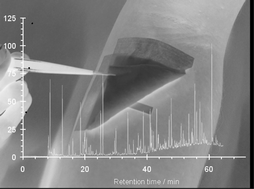The analytical utility of thermally desorbed polydimethylsilicone membranes for in-vivo sampling of volatile organic compounds in and on human skin†
Abstract
A thermally-desorbed polydimethylsilicone (PDMS) membrane approach with analysis by

* Corresponding authors
a The Centre for Instrumentation and Analytical Science at the School of Chemical Engineering and Analytical Science, The Faraday Tower, The University of Manchester, Sackville Street, Manchester, UK
b Unilever Research, Port Sunlight, Quarry Road East, Bebington, Wirral, UK
c
Department of Chemistry, Loughborough University, Leicestershire, UK
E-mail:
C.L.P.Thomas@Lboro.ac.uk
A thermally-desorbed polydimethylsilicone (PDMS) membrane approach with analysis by

 Please wait while we load your content...
Something went wrong. Try again?
Please wait while we load your content...
Something went wrong. Try again?
S. Riazanskaia, G. Blackburn, M. Harker, D. Taylor and C. L. P. Thomas, Analyst, 2008, 133, 1020 DOI: 10.1039/B802515K
To request permission to reproduce material from this article, please go to the Copyright Clearance Center request page.
If you are an author contributing to an RSC publication, you do not need to request permission provided correct acknowledgement is given.
If you are the author of this article, you do not need to request permission to reproduce figures and diagrams provided correct acknowledgement is given. If you want to reproduce the whole article in a third-party publication (excluding your thesis/dissertation for which permission is not required) please go to the Copyright Clearance Center request page.
Read more about how to correctly acknowledge RSC content.
 Fetching data from CrossRef.
Fetching data from CrossRef.
This may take some time to load.
Loading related content
